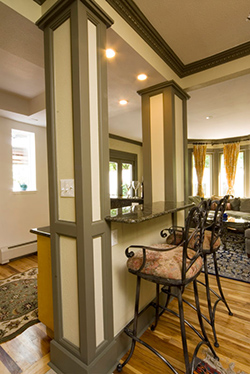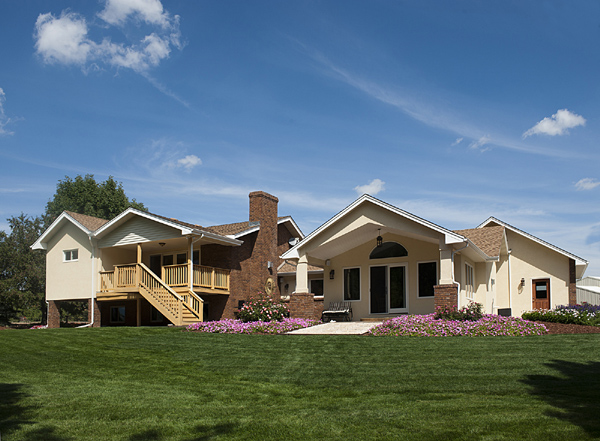Here are some tips that we have shared with our Denver area clients when we helped with their remodeling projects.

1) First, try to make a short list of your needs, wants and wishes in regard to your home. Needs are those items in your new floor plan that you absolutely must have. For instance, if your bathtub is old and leaking then a new tub or shower would be a need. Wants are those items that drive most large remodeling projects. Unlike needs, these are things that you could exist without or are living without currently, but living without them is making you increasingly uncomfortable. For instance, your life might really be improved with a new kitchen, or the master bedroom feels tight and confining, or there simply isn’t enough closet space for both of you. Wishes are those items that you would like to have if budget and time didn’t matter. Perhaps a full guest suite for occasional visits by relatives or a jetted tub with music, bubbles and mood lighting.
2) Make another list of those things in your house that bother you and that you don’t like. Discontent and discomfort is one of the primary motivations for remodeling. Simply put, what aspects of your home don’t you like? What are those items that make you cringe every time you see them or walk through the room(s). When I am working with remodeling clients I always want to be sure that we fix as many of the existing problems with their home as we possibly can.
3) Then decide on how much money you want to spend on fixing what needs to be fixed, improving what you would like to improve and splurging on those luxury items that you would really like to have. As a very rough guide to what remodeling might cost, large scale interior remodels run between $225 and $300 per SF, additions run between $350 and $400 per SF and up. Kitchens and bathrooms are the most expensive rooms to remodel. However, these two rooms also have a high resale and emotional value. See the link to on our website to Cost vs. Value for more exact remodeling cost information.
4) It would then be helpful to compare the benefits and costs of moving versus remodeling. Remember that you may need to do some remodeling in order to even sell your existing home. We hear from our clients over and over again, that a primary reason for their undertaking a remodeling project is that they really like the neighborhood they live in and therefore they don’t want to move. For example, where you live may be close to your work or schools, extended family, parks & cultural amenities, and friends or friendly neighbors. If you are thinking about moving farther away from work consider that there is a direct correlation between time spent commuting and happiness The less time spent commuting the greater is most people’s happiness. When thinking about moving costs don’t forget about fees for the realtors, bankers, lawyers, movers and stagers. Your time is also valuable and moving requires a lot of time spent on sorting, organizing, disposing, packing, unpacking and reorganizing. It will probably be difficult finding an already built, “dream home” in today’s hot real estate market. On the plus side for remodeling we can design and build to make your existing home match your dreams.
5) Try to do some project specific research. This doesn’t need to be too detailed. A short list of products and ideas that you find of interest will be helpful. If you are thinking about exterior changes, then try driving by interesting houses and take some photos. Talking to your neighbors may also be helpful. The Colorado Garden & Home Show held each February in Denver is well worth a visit. There are restrictions on where you can build on your lot and how large your project can be. So, if you have the time and want to do an addition, then a call to your building department to talk to a zoning official might be helpful. There is an overwhelming amount of useful (and worthless) information and photos available on the internet on websites such as Houzz and Pinterest. I always like to see a few photos of the kinds of ideas and styles that my clients are interested in.

6) Decide on the design & building process that you are going to use for your remodeling project. Your two basic options are; to try doing it yourself (DIY) or to hire professionals. There are benefits and costs to both approaches. The DIY approach usually works better for smaller projects in newer homes. The primary benefit is that DIY can save you some money. The downsides are that the project(s) will pretty much always take longer to build than you expect. Unless you have previous experience with planning and building remodeling projects, you will find that the project(s) will cost more then you expect as you run into unanticipated problems and unfulfilled wishes. You will also need to make sure that whatever you do conforms to current building codes. This can be difficult, because the current edition of the International Residential Building Code is 915 pages long.
There are two basic approaches to hiring professionals. The traditional approach is to first hire an architect to design your project, followed by hiring a general contractor who then builds your project according the plans that the architect drew up. The pitfalls of this approach are discussed in the “Process” and “Design-Build” articles on our website. We believe that a better approach is Design Build. This process is where you find a company that can both design and build your project. One big advantage of Design-Build is that you will have an accurate budget before you build and well before you spend the money on finalizing your construction plans.
7) Assuming you decide to hire professionals, then we recommend that you check out references, especially 3rd party references. An excellent screening tool is the Better Business Bureau. Companies that are members of the BBB generally are very concerned with maintaining a good reputation. This in turns means that they try to take care of their customers. Companies that are successful and good to work with usually have a long track record of treating customers well. References supplied by the architect or builder are helpful, but it is a rare company that will supply you with a bad reference on a project that went wrong. There are other third party referral services, but many of them will improve their listed companies standing, if the company pays extra for a better listing. One company that doesn’t do this is Guild Quality. This is a company that many remodelers and builders use to check customer satisfaction and quality of work. Obviously, if you are aware of a friend or neighbor that did a similar remodel you can discuss their experience with them.
8) Next, you can make some calls to designers and/or contractors and see how you are treated on the phone. It is always nice to reach a live person via phone, but more importantly, if you leave a message, does the company return your call? If they don’t return your initial call, then they probably won’t be returning your calls in the future. Is the person who reaches out to you, polite, interested, experienced and helpful to you on the phone? Do they answer your questions knowledgeably? Remodeling is a difficult process. It is very important that your questions are answered and that you are treated well from the very beginning of the process.

10) Finally, you will have to choose the team that you want to hire for your project. As I have tried to convey to you, your choice will probably involve weighing a number of factors and choosing the company that seems to represent the best solution to your concerns and desires. I think that the choice of a contractor should never be based solely on who tells you the lowest price for your project. There are simply too many ways that a devious contractor can avoid really delivering the lowest price to you. The lowest initial price is almost never the best value.
Good luck with your project.
John Happel for H & H Builders LLC
H & H Builders LLC
12295 Pennsylvania St, Suite 10 B
Denver, CO 80241
Tel: (303) 450-7006